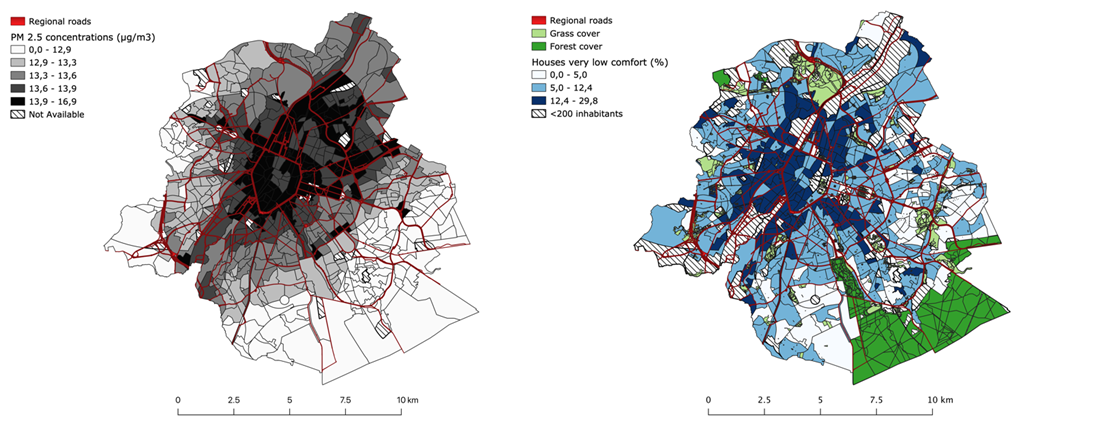VUB researchers present Green&Quiet Brussels project results
Promoting healthy urban environments is an overarching goal of today’s city planners and policy makers. Environmental elements such as green spaces, air- and noise pollution impact upon the quality of life and well-being of urban dwellers. Researchers from Interface Demography (Vrije Universiteit Brussel) investigated the impact of the objective and perceived living environment on health and wellbeing in Brussels in the project ‘Green&Quiet Brussels’ , funded by Innoviris. The main research results will be presented and discussed during the symposium ‘Santé Urbaine Bruxelles | Urbane Gezondheid Brussel’ on the 19th of October 2021.
The Brussels Capital Region is quite a green region. Not less than 19% of its territory consists of public green spaces, which is equivalent to 26 m2 per inhabitant. Moreover, measures to improve air and noise quality have been taken in the last years. Yet, the availability and quality of green spaces and the levels of noise and air pollution vary largely from one neighbourhood to another in Brussels. The Green&Quiet Brussels project investigates the health consequences of this unequal distribution of environmental quality in the Brussels capital region.
Environmental injustice and health inequalities related to air pollution
Air pollution is an urgent problem heavily compromising the health of Brussels’ residents. This conclusion is based on analyses of a rich dataset consisting of the whole Brussels population. In Brussels, being exposed to higher levels of ambient air pollution was associated with an increased risk of mortality from natural causes, cardiovascular and respiratory diseases. For each 5µg/m3 increment in PM2.5 concentrations, the risk of dying in Brussels increased by 17% for cardiovascular diseases and by 6% for respiratory diseases. This was independent of the levels of education, migrant background, and the social residential environment.
However, there were striking differences according to the socioeconomic characteristics of the neighbourhood. The mortality risk due to air pollution exposure in Brussels is highest in deprived neighbourhoods. For instance, for each 5µg/m3 increment in PM2.5 concentrations the risk of dying from cerebrovascular diseases in the wealthiest neighbourhoods increased by 16%, while in deprived neighbourhoods the risk increased by 86%. Similar results were observed for other air pollutants (such as PM10 or NO2) and for other causes of death. Socioeconomically deprived individuals living in Brussels are not only more exposed to harmful air pollution levels as shown in the maps below, they are also more vulnerable to its effects.
 Figure 1. Annual mean concentrations (µg/m3) of fine particulate matter (PM2.5) [left] and percentage of houses with very low comfort [right], per statistical sector. Sources: Air pollution data from IRCEL-CELINE, percentage of houses with very low comfort from 2001 Belgian census, and green spaces from Urbis map.
Figure 1. Annual mean concentrations (µg/m3) of fine particulate matter (PM2.5) [left] and percentage of houses with very low comfort [right], per statistical sector. Sources: Air pollution data from IRCEL-CELINE, percentage of houses with very low comfort from 2001 Belgian census, and green spaces from Urbis map.
Inequalities in the availability, accessibility and quality of public green spaces
The Green&Quiet project also gathered qualitative data through 51 individual in-depth face-to-face interviews with Brussels citizens. Research results showed that the use of public green spaces is perceived as contributing to physical and even more to mental health. This is also supported by our quantitative analysis demonstrating that residing near greener environments in Brussels decreases the risk of reporting poor self-perceived health and of dying from natural causes. From a health perspective it is therefore important that people can use public green spaces. Public green spaces should be available, accessible and of good quality. Our research clearly showed that green spaces will be under-used, even avoided when they are perceived as non-attractive. The idea of attractiveness consists of both a physical component and a social component. From a physical perspective, our project shows that there is a pronounced need for natural, clean and spacious public green spaces.
The COVID-19 epidemic – especially during the lockdowns – increased the need for qualitative public green spaces and magnified the problem of their unequal provision, accessibility and quality. In a period with severe restrictions in all fields of (social) life, public green spaces offered a unique place to meet others at a safe distance, to break through social isolation, to move, play and relax and to flee overcrowded and hot houses. Many restrictions impacted negatively upon the availability (restricitions regarding non-essential movements, closing public green spaces), accessibility (curfew) and attractiveness (closure of sport infrastructure, playground of public green spaces, prohibition to sit down) of public green spaces. As future pandemics might occur and restrictions might force us (again) to reconnect with our immediate living environment, it is important that every person residing in Brussels – regardless of the neighbourhood– can enjoy the health-improving effects of public green spaces.
The provision of qualitative public green spaces is urgent especially in more deprived neighbourhoods. Considering our quantitative results that the strongest beneficial health effect of living near greener areas is found among low-educated individuals, policy makers should prioritize the development and enhancement of green spaces for residents with low educational attainment, often living in poorer neighborhoods and conditions with limited access to health promoting resources.